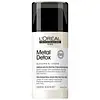What's inside
What's inside
 Key Ingredients
Key Ingredients

No key ingredients
 Benefits
Benefits

 Concerns
Concerns

 Ingredients Side-by-side
Ingredients Side-by-side

Water
Skin ConditioningIsopropyl Myristate
EmollientDimethicone
EmollientAmodimethicone
Triethanolamine
BufferingPhenoxyethanol
PreservativeCarbomer
Emulsion StabilisingPolyquaternium-4
Potato Starch Modified
Hydroxypropyl Guar
Emulsion StabilisingBehentrimonium Chloride
PreservativeArginine
MaskingTrideceth-6
EmulsifyingIsopropyl Alcohol
SolventCetrimonium Chloride
AntimicrobialLinalool
PerfumingGlycine
BufferingSerine
MaskingTyrosine
MaskingCitric Acid
BufferingGlutamic Acid
HumectantCoumarin
PerfumingBenzyl Alcohol
PerfumingBenzyl Benzoate
AntimicrobialAlpha-Isomethyl Ionone
PerfumingParfum
MaskingWater, Isopropyl Myristate, Dimethicone, Amodimethicone, Triethanolamine, Phenoxyethanol, Carbomer, Polyquaternium-4, Potato Starch Modified, Hydroxypropyl Guar, Behentrimonium Chloride, Arginine, Trideceth-6, Isopropyl Alcohol, Cetrimonium Chloride, Linalool, Glycine, Serine, Tyrosine, Citric Acid, Glutamic Acid, Coumarin, Benzyl Alcohol, Benzyl Benzoate, Alpha-Isomethyl Ionone, Parfum
Water
Skin ConditioningButylene Glycol
HumectantAminopropyl Dimethicone
Isododecane
EmollientIsononyl Isononanoate
EmollientGlycine
BufferingPEG-240/Hdi Copolymer Bis-Decyltetradeceth-20 Ether
StabilisingUndecane
EmollientCaprylyl Glycol
EmollientSclerotium Gum
Emulsion StabilisingTridecane
PerfumingTocopherol
AntioxidantEthylhexyl Salicylate
UV AbsorberLimonene
PerfumingSodium Citrate
BufferingCitric Acid
BufferingHexyl Cinnamal
PerfumingLinalool
PerfumingCitral
PerfumingGeraniol
PerfumingCoumarin
PerfumingPotassium Laurate
EmulsifyingPolyquaternium-7
Sodium Benzoate
MaskingHelianthus Annuus Seed Oil
EmollientParfum
MaskingWater, Butylene Glycol, Aminopropyl Dimethicone, Isododecane, Isononyl Isononanoate, Glycine, PEG-240/Hdi Copolymer Bis-Decyltetradeceth-20 Ether, Undecane, Caprylyl Glycol, Sclerotium Gum, Tridecane, Tocopherol, Ethylhexyl Salicylate, Limonene, Sodium Citrate, Citric Acid, Hexyl Cinnamal, Linalool, Citral, Geraniol, Coumarin, Potassium Laurate, Polyquaternium-7, Sodium Benzoate, Helianthus Annuus Seed Oil, Parfum
Ingredients Explained
These ingredients are found in both products.
Ingredients higher up in an ingredient list are typically present in a larger amount.
Citric Acid is an alpha hydroxy acid (AHA) naturally found in citrus fruits like oranges, lemons, and limes.
Like other AHAs, citric acid can exfoliate skin by breaking down the bonds that hold dead skin cells together. This helps reveal smoother and brighter skin underneath.
However, this exfoliating effect only happens at high concentrations (20%) which can be hard to find in cosmetic products.
Due to this, citric acid is usually included in small amounts as a pH adjuster. This helps keep products slightly more acidic and compatible with skin's natural pH.
In skincare formulas, citric acid can:
While it can provide some skin benefits, research shows lactic acid and glycolic acid are generally more effective and less irritating exfoliants.
Most citric acid used in skincare today is made by fermenting sugars (usually from molasses). This synthetic version is identical to the natural citrus form but easier to stabilize and use in formulations.
Read more about some other popular AHA's here:
Learn more about Citric AcidCoumarins are a group of substances found naturally in plants. There are over 1300 types of coumarins identified. It has a natural vanilla scent.
Coumarin is an identified EU known allergy, meaning it may cause an allergic reaction when applied to the skin.
In many countries, coumarin is banned as a food additive. However, it can be found in soaps, tobacco products, and some alcohol drinks.
Plants use coumarins as a chemical defense. Some plants that have coumarins include lavender, tonka beans, and yellow clovers.
Learn more about CoumarinThis ingredient is an amino acid that helps build proteins and moisturizes skin. It is already present in our skin as our bodies produce them naturally.
Glycine already plays a role in helping keep our skin moisturized as amino acids transport moisture throughout our skin.
As collagen is made up of glycine and other amino acids, it is believed glycine may help our skin produce more collagen.
Learn more about GlycineLinalool is a fragrance and helps add scent to products. It's derived from common plants such as cinnamon, mint, citrus, and lavender.
Like Limonene, this ingredient oxidizes when exposed to air. Oxidized linalool can cause allergies and skin sensitivity.
This ingredient has a scent that is floral, spicy tropical, and citrus-like.
Learn more about LinaloolParfum is a catch-all term for an ingredient or more that is used to give a scent to products.
Also called "fragrance", this ingredient can be a blend of hundreds of chemicals or plant oils. This means every product with "fragrance" or "parfum" in the ingredients list is a different mixture.
For instance, Habanolide is a proprietary trade name for a specific aroma chemical. When used as a fragrance ingredient in cosmetics, most aroma chemicals fall under the broad labeling category of “FRAGRANCE” or “PARFUM” according to EU and US regulations.
The term 'parfum' or 'fragrance' is not regulated in many countries. In many cases, it is up to the brand to define this term.
For instance, many brands choose to label themselves as "fragrance-free" because they are not using synthetic fragrances. However, their products may still contain ingredients such as essential oils that are considered a fragrance by INCI standards.
One example is Calendula flower extract. Calendula is an essential oil that still imparts a scent or 'fragrance'.
Depending on the blend, the ingredients in the mixture can cause allergies and sensitivities on the skin. Some ingredients that are known EU allergens include linalool and citronellol.
Parfum can also be used to mask or cover an unpleasant scent.
The bottom line is: not all fragrances/parfum/ingredients are created equally. If you are worried about fragrances, we recommend taking a closer look at an ingredient. And of course, we always recommend speaking with a professional.
Learn more about ParfumWater. It's the most common cosmetic ingredient of all. You'll usually see it at the top of ingredient lists, meaning that it makes up the largest part of the product.
So why is it so popular? Water most often acts as a solvent - this means that it helps dissolve other ingredients into the formulation.
You'll also recognize water as that liquid we all need to stay alive. If you see this, drink a glass of water. Stay hydrated!
Learn more about Water